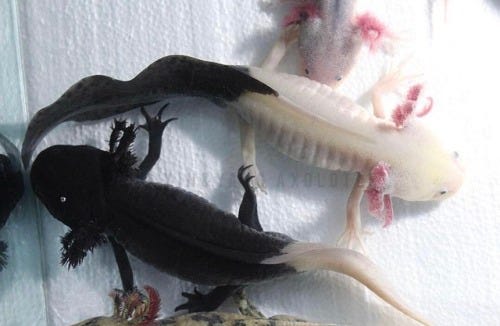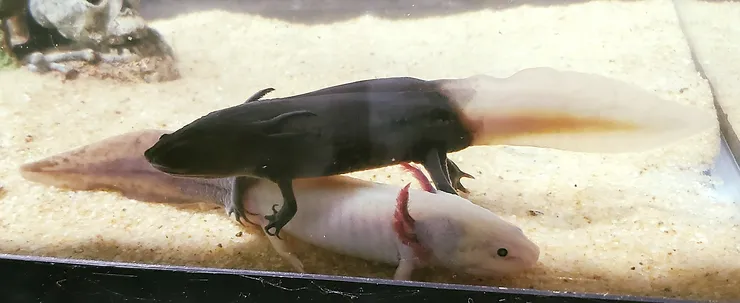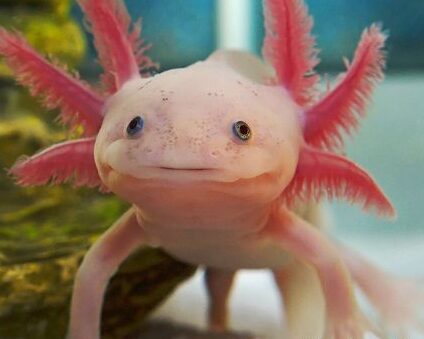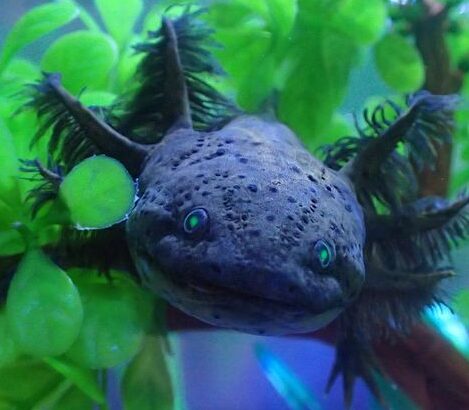
The firefly axolotl, a captivating creature that bridges the gap between terrestrial and aquatic life, has become an increasingly popular choice among exotic pet enthusiasts. With its unique charm and otherworldly appearance, the firefly axolotl stands out as a truly fascinating aquatic companion. Its distinctive features, mesmerizing colors, and remarkable regenerative abilities make it an intriguing addition to any aquarium.
Firefly Axolotl Facts
Delving into the world of firefly axolotls reveals a trove of interesting facts. These creatures, often referred to as “Mexican walking fish,” exhibit a diverse range of colors, including striking hues of pink, gold, and black. Known for their external gills that resemble feather-like structures, firefly axolotls showcase a blend of aquatic elegance and quirky charm. As captivating as their appearance may be, understanding their natural habitat is crucial to providing them with optimal care and ensuring their well-being in captivity.
Appearance and Characteristics
The appearance of firefly axolotls is truly enchanting. Their smooth, slim bodies adorned with feathery gills create a surreal aesthetic. Notably, these creatures are neotenic, retaining juvenile characteristics throughout their lives. Their mesmerizing colors, ranging from the ethereal glow of gold to the soft pinkish hues, contribute to their mystical allure. Observing their graceful movements in the water is akin to witnessing a living work of art, making them a delightful spectacle in any aquarium.
Natural Habitat
In their natural habitat, firefly axolotls are primarily found in the ancient lake complex of Xochimilco in Mexico. These freshwater creatures thrive in cool, slow-moving waters with abundant aquatic vegetation. Understanding the conditions of their native environment is crucial for recreating a suitable habitat in captivity. From water temperature to tank setup, mimicking the features of Xochimilco ensures that firefly axolotls feel at home, promoting their health and longevity.
Firefly Axolotl Habits
Understanding the habits of firefly axolotls is key to providing them with a thriving environment in captivity. These captivating creatures, known for their aquatic grace, exhibit fascinating behaviors that capture the attention of enthusiasts. Observing their habits enhances the bond between caretaker and axolotl, turning the aquarium into a dynamic and enchanting ecosystem.
Behavior in Captivity
Creating an ideal living space for firefly axolotls involves replicating their natural environment to encourage natural behaviors. These creatures are generally calm and slow-moving, making them well-suited for aquarium life. However, they do appreciate hiding spots and ample aquatic vegetation to retreat to, especially during daylight hours when they are more reclusive. Understanding their behavior in captivity allows caretakers to tailor the tank setup, ensuring that the axolotls feel secure and comfortable.
Feeding Habits
Unraveling the feeding habits of firefly axolotls unveils insights into their dietary needs and preferences. These carnivorous amphibians have a penchant for live or frozen foods, such as earthworms, bloodworms, and brine shrimp. Feeding should be done in moderation, typically two to three times a week, to prevent overfeeding and maintain water quality. Observing their feeding habits is not only practical for nutritional reasons but also provides caretakers with an opportunity to interact with these remarkable creatures.
Engaging with the habits of firefly axolotls goes beyond basic care routines; it allows caretakers to appreciate the nuances of their personalities. From the way they explore their tank to how they respond to stimuli, each behavior adds a layer of intrigue to the axolotl-keeping experience. In the next sections, we’ll delve deeper into their lifespan, pricing considerations, and monthly care costs, offering a comprehensive guide to those intrigued by the world of firefly axolotls.
Firefly Axolotl Lifespan
The allure of firefly axolotls extends beyond their captivating appearance to the promise of a long-lasting companionship. Understanding the lifespan of these aquatic wonders is crucial for anyone embarking on the journey of caring for these mesmerizing creatures. From their early stages of development to their twilight years, firefly axolotls exhibit a fascinating lifespan that captivates the hearts of enthusiasts.
Lifespan Expectancy
Firefly axolotls, when provided with optimal care, boast an impressive lifespan. On average, these creatures can thrive for 10 to 15 years in captivity. However, several factors influence their longevity. Adequate tank conditions, a well-balanced diet, and vigilant healthcare significantly contribute to ensuring a healthy and fulfilling life for your axolotl companion.
Proper tank maintenance plays a pivotal role in supporting their longevity. Regular water changes, maintaining appropriate water temperature, and ensuring a stress-free environment collectively contribute to extending their lifespan. Additionally, a nutritious and varied diet that meets their carnivorous needs is paramount for their overall well-being.
While firefly axolotls are hardy creatures, caretakers should remain attentive to signs of illness or distress. Swift action in response to any abnormalities can play a crucial role in maintaining their health and maximizing their lifespan.
The prospect of sharing a decade or more with these enchanting creatures adds a layer of depth to the commitment of axolotl ownership. Witnessing their growth, observing their behaviors, and ensuring their well-being throughout their lifespan transforms the care routine into a rewarding journey. As we explore further into considerations like pricing and monthly care costs, the commitment to understanding and enhancing the firefly axolotl’s lifespan remains at the forefront of responsible caretaking.
Firefly Axolotl Price
Embarking on the enchanting journey of bringing a firefly axolotl into your home comes with the consideration of the initial investment – the price of acquiring one of these captivating aquatic creatures. Firefly Axolotl prices typically range from $30 to $100, influenced by factors such as color variation, size, and breeder reputation. The allure of their unique appearance and intriguing behaviors often makes them a sought-after addition to aquariums, but understanding the typical price range is essential for prospective axolotl enthusiasts.
While prices can vary based on factors such as color variation, size, and the reputation of the breeder or seller, a firefly axolotl is generally priced within a range that makes them accessible to dedicated hobbyists. Reputable breeders, who prioritize the health and genetics of the axolotls they produce, may charge a premium compared to less scrupulous sources.
Cost Considerations
Beyond the initial purchase price, prospective axolotl owners should also consider the ongoing costs associated with their care. Axolotls have specific requirements, including an appropriate tank setup, water conditioning equipment, and a suitable diet, all of which contribute to the overall cost of ownership. Factor in expenses for high-quality aquarium equipment, including filters, lighting, and hiding places to create a comfortable environment for your aquatic companion.
Regular veterinary check-ups and potential medical expenses should also be part of your budgetary considerations. While axolotls are generally hardy, unexpected health issues can arise. And having financial provisions for such situations is a responsible approach to pet ownership.
Firefly Axolotl Monthly Cost
Owning a firefly axolotl is not just a delightful companionship but also a responsibility that involves ongoing monthly costs to ensure their well-being. The monthly cost of caring for a Firefly Axolotl, including food, tank maintenance, and potential veterinary expenses, averages between $20 to $50. Understanding the monthly expenses associated with axolotl care is crucial for providing a comfortable and thriving environment. From their dietary needs to tank maintenance, budgeting for the monthly costs ensures that these aquatic wonders continue to enchant for years to come.
| Expense Category | Estimated Monthly Cost (USD) |
|---|---|
| Food | $10 – $20 |
| Tank Maintenance | $5 – $15 |
| Water Testing Kits | $5 – $10 |
| Veterinary Contingency | $5 – $10 |
| Total | $25 – $55 |
Budgeting for Maintenance
Creating a comprehensive budget for maintaining a firefly axolotl involves considering various factors that contribute to their overall care. One of the primary considerations is the cost of their food. Axolotls are carnivorous and thrive on a diet of live or frozen foods, including earthworms, bloodworms, and brine shrimp. Estimating the monthly cost of these nutritional elements allows caretakers to plan for their dietary needs.
Additionally, aquarium maintenance is a key aspect of budgeting. Regular water changes, filtration system upkeep, and ensuring optimal water conditions are vital for the health of firefly axolotls. Investing in quality water testing kits and water conditioners is an ongoing expense that contributes to the overall well-being of the axolotl.
Budgeting should also account for potential veterinary costs. While axolotls are generally hardy, unforeseen health issues can arise. Having a financial buffer for veterinary care is a responsible approach to addressing any health concerns promptly.
Considering the monthly cost as part of the overall commitment to axolotl ownership ensures a stable and nurturing environment. As caretakers immerse themselves in the fascinating world of firefly axolotls. Balancing the joy of companionship with a well-thought-out budget enhances the overall experience of caring for these captivating aquatic creatures.
Firefly Axolotl For Sale

The prospect of bringing a firefly axolotl into your home is an exciting journey, but it begins with finding a reliable source from which to acquire these captivating aquatic companions. Whether you are a seasoned hobbyist or a newcomer to the world of exotic pets, ensuring that you obtain your firefly axolotl from a reputable and ethical source is paramount for the well-being of your future aquatic friend.
Finding a Reliable Source
When searching for firefly axolotls for sale, it’s crucial to do thorough research on potential sources. Reputable breeders who prioritize the health and genetics of their axolotls are often the best choice. Look for breeders who adhere to ethical breeding practices, ensuring the well-being of the axolotls throughout their lives.
One effective way to find a reliable source is through recommendations from experienced axolotl enthusiasts or reputable online forums and communities dedicated to amphibian care. Reading reviews and testimonials from previous customers can also provide valuable insights into the reputation of a breeder or seller.
Adoption is another option worth exploring. Rescue organizations or individuals looking to rehome their axolotls may offer a compassionate choice for those seeking to provide a home for these creatures in need.
Consider the transparency and willingness of the breeder or seller to provide information about the axolotl’s health history, lineage, and the conditions in which they were raised. A trustworthy source will be open and communicative, ensuring that you have all the information needed to create a suitable environment for your new aquatic companion.
FAQs
Q: What is the average size of a firefly axolotl?
A: Firefly axolotls typically grow to a size of 9 to 12 inches.
Q: Can firefly axolotls change their colors?
A: Yes, their colors can change based on factors like stress, age, and environment.
Q: How often should I feed my firefly axolotl?
A: Feed them two to three times a week, adjusting based on their appetite.
Q: Do firefly axolotls require a specific water temperature?
A: Maintain a cool water temperature between 60°F and 64°F for their well-being.
Q: What is the average lifespan of a firefly axolotl in captivity?
A: With proper care, they can live up to 10 to 15 years in captivity.
Q: Can firefly axolotls live with other aquatic species?
A: They are best kept in a species-only tank to avoid stress and potential harm.
Q: Are firefly axolotls nocturnal or diurnal?
A: They are primarily nocturnal, being more active during the night.
Q: How often should I clean the tank of my firefly axolotl?
A: Perform partial water changes every 2 to 4 weeks to maintain water quality.
Q: Are firefly axolotls suitable for beginners?
A: Yes, they are generally suitable for beginners due to their hardy nature.
Q: Can firefly axolotls regrow lost body parts?
A: Yes, they exhibit remarkable regenerative abilities, including limb regeneration.
Conclusion
In the captivating realm of aquatic companionship, the firefly axolotl emerges as a truly enchanting creature, bridging the worlds of curiosity and responsibility. As we’ve explored various facets of these mesmerizing beings – from their unique characteristics to considerations of cost, lifespan, and finding a reliable source – a tapestry of knowledge has been woven, guiding enthusiasts on a journey into the depths of axolotl care.
The allure of firefly axolotls lies not only in their ethereal appearance but also in the joy they bring to those who embrace the responsibilities of their guardianship. Understanding their habits, ensuring an optimal environment, and budgeting for their needs contribute to a fulfilling companionship that can span a decade or more.
With 3 years of devoted companionship alongside my aquatic friend, Bob, I’ve gained profound insights into the captivating world of fishkeeping. From understanding behavior to ensuring optimal health, my journey with Bob has enriched my expertise in all things aquatic.




Pingback: Piebald Axolotl: Things You Need to Know About - Fish Hue
Pingback: Axolotl Feeding Guide: Age, Times, Do's and Don'ts - Fish Hue
Pingback: Axolotl Vision: A Comprehensive Guide - Fish Hue
Pingback: Do Axolotls Lay Eggs? - Fish Hue
Pingback: Safe Water for Axolotl: Finding the Best Water Type - Fish Hue